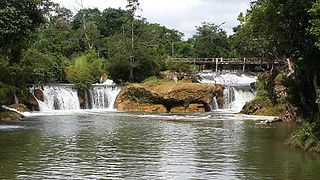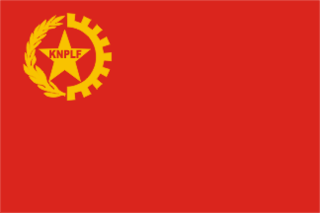
Kayah State, or Karenni State, is a state of Myanmar. Situated in eastern Myanmar, it is bounded on the north by Shan State, on the east by Thailand's Mae Hong Son Province, and on the south and west by Kayin State. It lies approximately between 18° 30′ and 19° 55′ north latitude and between 96° 50′ and 97° 50′ east longitude. The area is 11,670 km2 (4,510 sq mi). Its capital is Loikaw. The estimated population in the 2014 Myanmar Census was 286,738, the smallest among Myanmar's seven states. It is inhabited primarily by the Karenni ethnic group, also known as Red Karen or Kayah, a Sino-Tibetan people.

The Karenni Army is the armed wing of the Karenni National Progressive Party (KNPP), and operates in eastern Kayah State, Myanmar (Burma).

The Karenni National People's Liberation Front (KNPLF) is a communist and Karenni nationalist insurgent group active in Kayah State, Myanmar (Burma). It agreed to become a government-sponsored border guard force on 8 November 2009 although it remains active under the name of KNPLF. Starting from 13 June 2023, it has decided to change sides to the Karen National Liberation Army (KNLA), Karenni Army (KA), Karenni Nationalities Defense Force (KNDF), and People's Defense Force (PDF) and fight the military regime.
Violent clashes have been ongoing in the northern part of Myanmar's Rakhine State since October 2016. Insurgent attacks by the Arakan Rohingya Salvation Army (ARSA) have led to sectarian violence perpetrated by Myanmar's military and the local Buddhist population against predominantly Muslim Rohingya civilians. The conflict has sparked international outcry and was described as an ethnic cleansing by the United Nations High Commissioner for Human Rights. In August 2017, the situation worsened and hundreds of thousands of refugees fled Myanmar into Bangladesh, with an estimated 500,000 refugees having arrived by 27 September 2017. In January 2019, Arakan Army insurgents raided border police posts in Buthidaung Township, joining the conflict and beginning their military campaign in northern Rakhine State against the Burmese military.

Zaw Min Tun, is a Burmese army general and the current Deputy Minister of Information in Myanmar. He serves concurrently as the Chief of the Tatmadaw True News Information Team and heads the Press Team of the State Administration Council (SAC). Zaw Min Tun is acknowledged as a senior spokesman for the Myanmar Army.

The People's Defence Force is the armed wing of the National Unity Government in Myanmar. The armed wing was formed by the NUG from youths and pro-democracy activists on 5 May 2021 in response to the coup d'état that occurred on 1 February 2021 that put the military junta and their armed wing the Tatmadaw in power. The military junta designated it as a terrorist organisation on 8 May 2021. In October 2021, NUG's Ministry of Defence announced that it had formed a central committee to coordinate military operations across the country.

The Myanmar civil war, also called the Burmese Spring Revolution, Burmese civil war or People's Defensive War, is an ongoing civil war following Myanmar's long-running insurgencies, which escalated significantly in response to the 2021 military coup d'état and the subsequent violent crackdown on anti-coup protests. The NUG and major ethnic armed organisations repudiated the 2008 Constitution and called instead for a democratic federal state. Besides engaging the rebels, the junta also contends with anti-junta forces in areas under its control.

The Karenni Nationalities Defence Force is an armed insurgent group in Myanmar formed in response to the 2021 Myanmar coup d'état. The KNDF also includes other organizations, such as the KNPP, which an official regard as "good relations between the EAOs and the public" The KNDF has engaged in fighting with the junta, mainly with the 66th Light Infantry Division.
Events in the year 2022 in Myanmar.
On the night of 23 October 2022, the Myanmar Air Force launched a series of airstrikes in Hpakant Township, Kachin State, Northern Myanmar. The targeted area was within the territory of the Kachin Independence Organization's 9th Brigade in the Anangpa (အနန့်ပါ) area. The airstrikes hit an outdoor concert killing at least 80 civilians, including KIO officials and musical performers.
The following is a timeline of major events during the Myanmar civil war (2021–present), following the 2021 military coup d'état and protests. It was also a renewed intensity in existing internal conflict in Myanmar.
This is the list of important events happened in Myanmar in 2023.
The Let Yet Kone massacre was a mass killing of civilians on 16 September 2022, at a monastic school in the village of Let Yet Kone, near Tabayin in Sagaing Region, in north-western Myanmar. During the massacre, Myanmar Army and Myanmar Air Force troops killed at least 13 civilians, including 8 children. The event became one of Myanmar's deadliest civilian massacres involving children in 2022, during which 165 children were killed by military forces.
The Pinlaung massacre was a mass killing of civilians by Burmese military forces on 11 March 2023, in the village of Namneng, Shan State. During the massacre, Myanmar Army troops killed at least 30 civilians, including 3 Buddhist monks. The massacre occurred 9 days after the Tar Taing massacre in Sagaing.

The Mon Taing Pin massacre was a mass killing of civilians by Burmese military forces on 11 May 2022, in the village of Mondaingbin, Sagaing Region, Myanmar. During the massacre, Myanmar Army troops executed at least 37 villagers. Sagaing Region later became the site of several additional mass killings perpetrated by the Burmese military, including the Letyetkon and Tadaing massacres.
The 2021 Battle of Loikaw was an engagement between the Tatmadaw against ethnic Karenni militias and local PDF civilian guerrillas. The battle began on 21 May 2021, and was one of the first engagements of the current Myanmar Civil War in Kayah State.
The 2022 Battle of Loikaw was a battle for the city of Loikaw, in Myanmar's Kayah State, between January and July 2022. The State Administration Council's Tatmadaw forces attacked the city at the beginning of 2022, which was being held by the Karenni Nationalities Defence Force and local People's Defence Force groups. The fighting caused over 90,000 people in Loikaw Township to flee.
The First Battle of Demoso began on May 21, 2021, between the forces of the State Administration Council junta and Karenni separatist groups allied with the anti-junta People's Defence Force (PDF) during the 2021 Myanmar civil war. The battle took place over the span of a few weeks in the city of Demoso and surrounding villages, eventually ending in a ceasefire between the two parties.
Operation 1107 is an ongoing joint military operation launched on 7 November 2023, by the Karenni National People's Liberation Front, Karenni Army, and Karenni Nationalities Defence Force against the Tatmadaw military junta in Myanmar, during the Myanmar civil war. It was launched in support of the concurrent Operation 1027 by other rebel forces in Myanmar.
Operation 1111 is an ongoing military operation launched by Karenni Ethnic Armed Organisations (EAOs) including the Karenni Army (KA), Karenni Nationalities Defence Force (KNDF) and Karenni National People's Liberation Front (KNPLF). The operation was launched concurrently with Operation 1107, with the goal to capture Kayah State's capital city of Loikaw.








